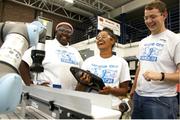
Developing Photonics Education in Iowa's Rural Secondary Schools
nsf.gov/awardsearch/showAward?AWD_ID=1800935
Photonics is a rapidly growing field that encompasses the science and technologies related to lasers and optics. Photonics applications are important in many industries, ranging from defense to manufacturing to healthcare. This broad application base creates a continued high demand for photonics technicians in the United States. In this project, Indian Hills Community College will seek to increase the number of photonics technicians by encouraging secondary school students to enter a pathway that leads to photonics technician careers. The project will emphasize rural high school students who rarely have learning opportunities in state-of-the-art technologies. The project will enable rural high school students to earn college credit that transfers directly to a two-year photonics degree. This dual credit opportunity will position the students to enroll in, complete a degree program, and obtain a job in the high-demand photonics field. The project will also test the potential of hybrid online instruction to bring advanced technical education into the classrooms of rural school districts, which often have limited budgets. Rural high school teachers will also receive photonics-related professional development.
The primary goal of this project is to increase the number of rural Iowa high school students in photonics technician career pathways. The project will build on work completed by the Midwest Photonics Education Center, an ATE Regional Center at Indian Hills Community College that focused on educating photonics technicians in the Midwest. Portable photonics kits developed by the Midwest Photonics Education Center will be used for lab activities in the hybrid online courses that will be developed in this project. These kits help students learn photonics concepts through hands-on activities without the need to equip an entire lab. Industry partnerships will also be leveraged to enhance the project activities. The project materials, results, and best practices will be widely disseminated to facilitate the adoption or adaptation of the approach by other community colleges.







